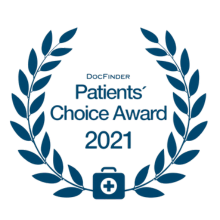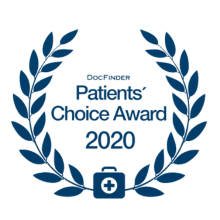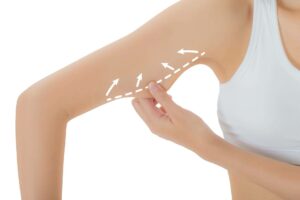Sweat gland suction
or
blockage in Vienna
Excessive sweating (hyperhidrosis) can be treated by suctioning or blocking the sweat glands. This reduces sweat production to a normal level.
The most important facts about sweat gland treatment for hyperhidrosis
- Final result with suction: After approx. 2-3 weeks (swelling, bruising)
- Final result with blockage: After approx. 1 week
- Recovery time: 1 day
- Ability to work: After 1 day, however, swelling and bruising may occur
- Pain: Low
- Sport: Light sport after approx. 2 weeks
- Cost of sweat gland suction: € 2.690,-
- Cost of sweat gland blockade: 790,-
Consultation with Dr. Roland Resch
Feel free to book a consultation with Dr. Roland Resch
Treatment of the sweat glands for excessive sweating - hyperhidrosis
A job interview or a party can quickly turn into a nightmare. Even the fear of sweating can trigger an attack. The jacket is kept on, the jacket is not taken off. Wearing a cocktail dress becomes an impossibility, because no woman wants to attend a party with sweat stains under her arms.
If the hands are affected by sweating, those affected try to avoid shaking hands or, for example, always hold a glass in their hand to conceal the respective body area.
But everyday life is also not pleasant for people with excessive sweat production. Sweat stains are not only not a pretty sight, they are also extremely unpleasant and extremely stressful for those affected.
Causes of hyperhidrosis
Sweat and perspiration are essential for human life, as they are very important ways of regulating body temperature. But there are also people who sweat too much due to illness.
The cause of increased sweating is not yet fully understood. It is assumed that up to 10% of the population suffer to a greater or lesser extent from hyperhidrosis.
Many people suffer from sweating
The number of people who suffer from excessive sweating, known as hyperhidrosis, is very high. Sweat production is increased and those affected usually sweat more in the armpit area or on the hands. Sometimes the head and feet can be affected as well as the armpit area.
Sweat gland curettage is an option:
You feel severely restricted in your daily life due to excessive sweating.
If you suffer from excessive sweat production under the armpits.
You sweat excessively on your hands or feet.

Suffering from excessive sweating
Persons with exessive sweating tend to by white or black clothes as sweat stains are less visible wih these colours. Clothes also have to be replaced and new ones bought more often than normal, as the excessive sweat from the clothes of affected people is difficult to remove.
It is not only the visible stains, but also the fear of smelling strongly that drives affected people to shower and change their clothes several times a day if possible.
People with sweat stains feel ashamed
These people are very ashamed of it because sweat stains are not socially accepted. Often these people are also afraid to tell their partner, which can put a strain on the relationship.









Two possible types of treatment for excessive sweating (hyperhidrosis)
Block sweat production
Block excessive sweating
A temporary blockage of the sweat glands is very effective in preventing excessive sweating or hyperhidrosis.
Procedure of a sweat blockade
In the armpit area, the treatment is performed under local anesthesia.
A nerve block is recommended for the hands and feet, or twilight anesthesia for anxious people, as punctures are sometimes painful.
The product is applied via 2 punctures in the armpit. Unfortunately, multiple punctures are necessary on the hands and feet.
The effect sets in after approx. 6-7 days.
The effect lasts for approx. 4-6 months, after which the treatment must be repeated.
The result of a sweat gland interruption
You no longer sweat at all once the effect has set in and remain mostly dry for a period of 4-6 months.
This method is very effective in eliminating excessive sweating (hyperhidrosis), as it can also be used to treat hands and feet.
Sweat gland curettage in the armpits
Sweat gland removement
In the surgical removal of sweat glands, known as sweat gland curettage, the armpits are treated; unfortunately, the hands and feet are not suitable for this method.
Procedure for sweat gland curettage
The armpit is shaved and locally anesthetized. The sweat glands are removed via one or two very small incisions. This is done in a similar way to liposuction, using special cannulas to suction out the sweat glands. This method is also known as sweat gland curettage.
This process takes about 10-20 minutes per side.
It is usually not necessary to sew up the small incisions. A bandage is applied for about 2 days. Bring a tight-fitting shirt or T-shirt to the operation, as the bandage fits better.
Aftercare and recovery
We will make the procedure as easy and comfortable as possible for you and help you to enjoy a new quality of life. We will provide you with detailed instructions on post-operative care, as well as information on normal symptoms and signs of possible complications.
You have a special bandage in the armpit. You will usually be given bandages so that you can change them yourself at home if necessary.
Showering is possible again on the first day after the operation.
Make sure you clean the operation area with mild washing lotion and then pat dry with a soft towel. You can then reapply the bandage if necessary.
We recommend that you take it easy physically for the first few days after the operation.
The recovery time for sweat gland suction is very short. Depending on your activity, you can return to your everyday working life very quickly. Office work can be resumed the next day, heavy and strenuous work after approx. 2 weeks.
Result of sweat gland suction
Sweat gland suction of the armpit can reduce sweating effectively and usually for a very long time by around 70-80% and thus reduce it to a normal level.
Make an appointment
Dr. Roland Resch is available for a personal consultation by appointment!
Sweat gland treatment - what you should know!
How do I prepare for a sweat gland treatment?
Before sweat gland removal, we will discuss the following points together in order to positively influence the success and avoid risks:
- General state of health and any illnesses
- The influence of nicotine on the wound healing process. If possible, avoid smoking for 3 weeks before the operation.
- Avoid aspirin and other anti-inflammatory drugs, as these greatly impair blood clotting.
- The same applies to herbal medicines and food supplements, as these can also affect blood clotting.
- There should be no acute or severe chronic illnesses that contraindicate a surgical procedure.
- Chronic illnesses such as high blood pressure or diabetes must be well controlled with medication.
- There must be NO acute infections such as flu, fever, angina, cold sores etc. or other acute illnesses.
- Prepare everything you will need after the operation at home and put the most important things within easy reach so that you don’t have to stretch too much after the operation and can devote yourself to your recovery.
- Also avoid excessive alcohol consumption during this time.
- Regardless of the type of procedure, drinking enough water before and after the procedure is necessary for recovery.
What are the risks of sweat gland curettage?
Every surgical procedure carries a certain risk. However, this can be classified as low in the case of sweat gland suction.
- In rare cases, post-operative bleeding or wound infections may occur, which can usually be well controlled with medication.
- Sometimes circulatory disorders of the skin or hardening or even so-called small necroses occur in the armpit area, which also usually do not require any special treatment.
How high is the risk of blocking sweat production?
Occasionally there are small bruises at the puncture sites, and rarely a certain feeling of weakness on the hands or feet.
Is the treatment of sweat glands carried out on an outpatient basis?
The surgical removal of sweat glands and the treatment of excessive sweating with a blockage are always carried out on an outpatient basis.
You can leave the surgery practically immediately after the operation/treatment.
Only extremely rarely, or if there are medical reasons such as serious illnesses, can inpatient follow-up observation after sweat gland removal be advisable.
In which cases is sweat gland treatment not possible?
Patients with chronic illnesses, such as high blood pressure or diabetes, must be well and stably controlled with medication. High blood pressure can increase the risk of bleeding, while diabetes increases the risk of infection.
- There must be no serious cardiovascular disease, such as coronary heart disease, or serious liver or kidney disease. This applies in particular to sweat gland suction.
- The standards for sweat gland blockage are not quite as strict.
- If you are taking medication to thin the blood, depending on the underlying illness, it may be necessary to clarify with your family doctor or internist whether the medication can be discontinued and whether an operation is justifiable.
- In certain chronic skin and connective tissue diseases (e.g. scleroderma, Ehlers-Danlos syndrome, etc.), sweat gland suction cannot be performed.
- If there are acute inflammatory diseases of the skin in the surgical area or certain chronic skin diseases, surgery is not recommended.
Does a combination with other treatments make sense?
A combination with other procedures, such as an eyelid lift, abdominoplasty or liposuction, is possible. It is important that these are so-called “aseptic” procedures. Talk to me about it!
When are sports, sauna and solarium allowed again after sweat gland removal?
- Sport is possible again after 2 weeks
- Solarium and intensive sun exposure can lead to brownish discoloration of the skin and scars in the first phase after the operation, which can occasionally be permanent. For this reason, I recommend avoiding tanning beds and sunbathing for the first 3 months after the operation. A sunscreen with a high sun protection factor (sun blocker) should then be used for a year. I will be happy to help you choose the right products.
- You should avoid going to the sauna for about 6 weeks.
- In general, stimuli that lead to heavy sweating should be restricted during the postoperative phase.
How much does a sweat gland treatment for excessive sweating (hyperhidrosis) cost?
Cost/price Sweat gland suction € 2.690,-
Sweat gland suction to combat excessive sweating:
Pre-op consultation, surgery information, surgery in the private OR, OR nurse, all follow-up checks.
Precise instructions for the first few days at home.
The cost of a blockage of the sweat glands comes to € 790 for the armpit.
Cost sweat blockade hands: € 790,-
Cost sweat blockage feet depending on your shoe size:
Size 36-39: € 790,-
Size 40-43: € 1.190,-
Size 44-48: € 1.590,-
The treatment of the feet is relatively painful and we recommend having the blockage of the sweat glands on the feet performed under general anesthesia. Costs for general anesthesia: € 750,-
Prices valid from 01.01.2024
What patients say about us
Very detailed consultation in which all my questions were answered AND explained very well by Dr. Resch. The operation was painless, I received a call from Dr. Resch on the same day in which he asked how I was feeling (great aftercare). The healing process went just as Dr. Resch had told me before the operation...... The whole team - receptionist, surgery nurse - is VERY nice and explains all the steps before and during the operation ....
Great people do a perfect job. Many thanks for that
I had my breast done by Dr. Resch, it was before the summer and I am soooooo happy! He suggested the operation with implants and it was really the right decision. Size, shape - everything is great! Everything was explained well and in detail. I was a bit scared and nervous, but I had almost no pain. I could have gone straight back to work, which really surprised me. It healed quickly and I was in the bath and had a hot summer with my new twins! Thank you, thank you, thank you!!!
I have had liposuction on my hips and thighs. From the first consultation to the 2nd check-up appointment, I was well looked after by the whole team and Dr. Resch and the results are really impressive. I can really only advise everyone to seek help here if they have an aesthetic problem!!!
WOW! I had a thread lift done by Dr. Resch to liften my face and chin line. I am more than thrilled. My husband says: 10 years younger! The advice and clarification were excellent and no questions were left unanswered. Dr. Resch also explained to me exactly what is achievable and what is not. The entire team is very friendly and empathetic. I felt very comfortable. I was able to go home shortly after the treatment. There was hardly any pain. The check-up appointments afterwards, which are included in the price, are also carried out in a relaxed and attentive manner. For me the best beauty doctor! 5 stars!
Dr. Resch lifted my upper and lower eyelids in a single operation. The result is a dream. Dr. Resch gave me incredibly good advice and showed me before and after pictures. He answered all my questions and also asked me in great detail about my ideas in order to harmonize reality and my expectations. My expectations were even exceeded: It's now been 3 months and you can't see the scars at all. Everything is firmer and the bags under the eyes have disappeared. The staff are also extremely empathetic and courteous, and the practice is also very nice. All in all, this doctor can really be recommended! Thanks to Dr. Resch
At the end of last year, I decided to have surgery to remove my gynecomastia, which had bothered me since my youth. I came across Dr. Resch, who made a very professional and emphatic impression from day one. After the initial consultation, I decided to have an operation with Dr. Resch.
The entire procedure, from making the appointment, pre-operative information, intra- and post-operative care, to the follow-up checks, was at the highest level.
The humanity of Dr. Resch and his team is particularly evident.
All questions were answered patiently and in detail, even outside of surgery hours.
Dr. Resch and the entire team can only be recommended!
Thank you!
As a specialist in plastic surgery and also surgery (this combination is rare to find) he is really highly recommended! He is very nice, competent and responds wonderfully to his patients' problems. What you quickly find very likeable is his down-to-earth attitude - i.e. he is not aloof like so many others in his industry. The support was excellent, his team is very friendly and the appointments are uncomplicated. I can only warmly recommend him and his team! Thanks to him I have a normal everyday life again without massive sweating! Thank you!
I have already had several procedures with Dr. Resch (eyelid lift, liposuction on the stomach and legs) and can only warmly recommend him - and his team! From the professional, empathetic and - in terms of the result - realistic consultation to the procedures in a reassuring, trusting environment, I felt that I was in good hands and very professionally looked after. I was also always very well looked after and advised during aftercare. Thanks to the whole team for the great all-round support!
I was interested in breast augmentation with autologous fat. Dr. Resch explained everything to me very precisely and also told me realistically what is possible. But I already knew from reading on the internet that only a certain amount of size increase was possible, which was completely ok for me. The operation wasn't bad at all, the girdle was a bit annoying. But hold on girls: bigger breasts, fat pads gone! Especially riding breeches and so over the waistband! It really paid off! Can only recommend Dr. Resch and his friendly team!
I had breast reduction surgery with Dr. Resch and it was a fantastic experience. Right from the beginning he lead me through the whole process of preparing for surgery, finally underwent surgery and all went well!!!! I am so happy with the results and finally feel so much lighter! My breasts were such a heavy load for so many years! Healing was also no problem and in the meantime the scars look fine! New breasts, new life! Thank you!





